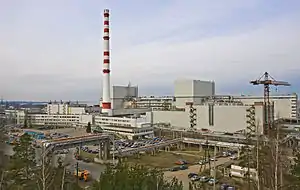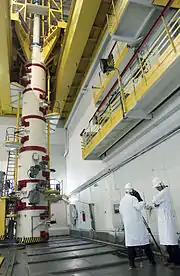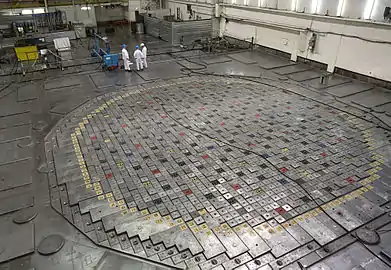Leningrad Nuclear Power Plant
Leningrad Nuclear Power Plant (Russian: Ленинградская атомная электростанция; Ленинградская АЭС Leningradskaya atomnaya elektrostantsiya; Leningradskaya AES (![]() pronunciation )) is a nuclear power plant located in the town of Sosnovy Bor in Russia's Leningrad Oblast, on the southern shore of the Gulf of Finland, some 70 kilometres (43 mi) to the west of the city centre of Saint Petersburg.
pronunciation )) is a nuclear power plant located in the town of Sosnovy Bor in Russia's Leningrad Oblast, on the southern shore of the Gulf of Finland, some 70 kilometres (43 mi) to the west of the city centre of Saint Petersburg.
| Leningrad Nuclear Power Plant | |
|---|---|
 Site of the Nuclear Power Plant Leningrad, including the construction site of the Nuclear Power Plant Leningrad II. | |

| |
| Country | Russia |
| Location | Sosnovy Bor, Leningrad Oblast |
| Coordinates | 59°50′50″N 29°02′37″E |
| Status | Operational |
| Construction began | 1 March 1970 (Leningrad Nuclear Power Plant I) 25 October 2008 (Leningrad Nuclear Power Plant II) |
| Commission date | 1 November 1974 (Leningrad Nuclear Power Plant I) Unit II-1: 29 October 2018 |
| Decommission date | 21 December 2018 (Leningrad Nuclear Power Plant I Unit 1), 10 November 2020 (Leningrad Nuclear Power Plant I Unit 2) |
| Owner(s) | Rosenergoatom |
| Operator(s) | |
| Nuclear power station | |
| Reactors | 8 |
| Reactor type | RBMK-1000 (Leningrad Nuclear Power Plant I) VVER-1200/V491 (AES-2006) (Leningrad Nuclear Power Plant II) |
| Reactor supplier | Atomstroyexport |
| Power generation | |
| Units operational | 2 × 925 MW 1 × 1085 MW |
| Units planned | 2 × 1085 MW |
| Units under const. | 1 × 1085 MW |
| Units decommissioned | 2 × 925 MW |
| Nameplate capacity | 2935 MW |
| Capacity factor | 60.5% |
| Annual net output | 21,208 GW·h |
| External links | |
| Website | lennpp |
| Commons | Related media on Commons |
As of 2021, the plant has four nuclear reactors of the RBMK-1000 type, of which unit one and two have been shut down. These reactors are similar to reactors No. 1 and 2 of the Chernobyl Nuclear Power Plant.
Plans are underway to replace the RBMK reactors with four new reactors of the VVER-1200 type, with the plant identification "Leningrad II". On 25 October 2008, Saint Petersburg Atomenergoproekt began concreting the foundation plate of the reactor building of the Leningrad Nuclear Power Plant II, Unit 1. The cost of the project was estimated at almost 70 billion Russian rubles (about $3 billion US dollars at the time).[1][2] A construction licence was issued on 22 July 2009.[3] In October 2018, Leningrad II-1 started commercial operation, and Leningrad II-2 was scheduled for the start of commercial operation in 2021. Leningrad II-3 and II-4 are planned, but construction has not yet started.
In December 2019, Leningrad II-1 was integrated into the district heating system of Sosnovy Bor and the local industrial park, replacing the heating capacity of the closed RBMK-1000 units. The thermal output is 3200 MW.[4]
From May 2012 to December 2013, Unit 1 was offline while repairs were made related to some deformed graphite moderator blocks.[5]
Reactor data
| Unit[6] | Reactor type | Net capacity (MW) |
Gross capacity (MW) |
Construction started |
Grid connection |
Commercial operation |
Shutdown | Cleared out |
|---|---|---|---|---|---|---|---|---|
| Leningrad - 1 | RBMK-1000 | 925 | 1000 | 1970-03-01 | 1973-12-21 | 1974-11-01 | 2018-12-21 | (2023) |
| Leningrad - 2 | RBMK-1000 | 925 | 1000 | 1970-06-01 | 1975-07-11 | 1976-02-11 | 2020-11-10 | - |
| Leningrad - 3 | RBMK-1000 | 925 | 1000 | 1973-12-01 | 1979-12-07 | 1980-06-29 | 2025-01-31 | - |
| Leningrad - 4 | RBMK-1000 | 925 | 1000 | 1975-02-01 | 1981-02-09 | 1981-08-29 | 2026-12-26 | - |
| Leningrad II - 1 | VVER-1200/491 (AES-2006) | 1085 | 1187 | 2008-10-25 | 2018-03-09[7] | 2018-10-29 | 2078 | - |
| Leningrad II - 2 | VVER-1200/491 (AES-2006) | 1085 | 1199 | 2010-04-15[8] | 2020-10-26[9] | (2021[10][11]) | - | - |
| Leningrad II - 3 | VVER-1200/491 (AES-2006) | 1085 | 1199 | (Planned)[12] | ? | ? | ? | - |
| Leningrad II - 4 | VVER-1200/491 (AES-2006) | 1085 | 1199 | (Planned)[13] | ? | ? | ? | - |
Incidents and accidents

The first accident at the plant occurred shortly after the first unit came online. On 7 January 1975, a concrete tank containing radioactive gases from Unit 1 exploded; there were no reported accident victims or radiation releases.[14][15]
Less than a month later, on 6 February 1975, the secondary cooling circuit of Unit 1 ruptured, releasing contaminated water into the environment. Three people were killed, and the accident was not reported in the media.[14][15]
On 28 November 1975, a fuel channel in Unit 1 suffered a loss of coolant, resulting in the degradation of a nuclear fuel assembly that led to a significant release of radiation lasting for one month. Immediately after the accident, the radiation level in Sosnovy Bor, 5 kilometres (3.1 mi) from the affected power unit, was 600 mR/h; in total, 1.5 MCi was released into the environment.[16] The exposed inhabitants of the Baltic region were not notified of the danger. The accident was not reported in the media. Practically the same accident occurred in Unit 1 of the Chernobyl Power Station in 1982[14][15][17]
In July 1976 and again in September 1979, due to a poor safety culture, a fire broke out in a concrete vault containing radioactive waste. Water used in extinguishing the fires was contaminated, leaked into the environment, and entered the water table. This was not reported in the media.[17][15]
On 28 December 1990, during refurbishment of Unit 1, it was noticed that the space between the fuel channels and the graphite stack (contaminated during the 1975 accident) had widened. The contaminated graphite was spilled, and the radiation levels in the space under the reactor increased. Radiation was detected 6 km away from the unit, but this was not reported in the media.[17][15]
On 3 December 1991, due to faulty equipment and lax safety rule compliance, 10 new fuel rods were dropped and damaged. The staff tried to conceal the accident from the plant's management.[15]
In March 1992, an accident at the plant leaked radioactive gases and iodine into the air through a ruptured fuel channel. This was the first accident at the station that was announced in the media.[18]
On 27 August 2009, the third unit was stopped when a hole was found in the discharge header of a pump.[19] According to the automated radiation control system, the radiation situation at the plant and in its 30-kilometre (19 mi) monitoring zone was normal.[19] The plant's management refuted rumors of an accident and stated that the third unit was stopped for a "short-term unscheduled maintenance", with a restart scheduled for 31 August 2009.[20]
On 19 December 2015, unit 2 was stopped (scrammed) due to a broken steam pipe. No radioactively contaminated material was released.
On 21 December 2018, the first unit of Leningrad NPP was shut down for decommissioning. The full unloading of the nuclear fuel from within the unit is planned to take until 2023.[21]
Electricity generation
- Production of Leningrad Units 1-4, 1974-2017 (TWh/year)
Gallery
 Reactor hall of one of the RBMK units
Reactor hall of one of the RBMK units.jpg.webp) Construction site for Leningrad Nuclear Power Plant II, April 2010
Construction site for Leningrad Nuclear Power Plant II, April 2010
References
- Leningrad NPP-2: Concreting of the foundation plate of the reactor building of the 1st unit started; 27 October 2008:
- Construction starts at Leningrad II; 27 October 2008:
- "Go-ahead for second Leningrad II unit". World Nuclear News. 22 July 2009. Retrieved 26 July 2009.
- "Leningrad II plant begins providing district heating". World Nuclear News. 2 December 2019. Retrieved 3 December 2019.
- "Restored RBMK back on line". World Nuclear News. 2 December 2013. Retrieved 3 December 2013.
- Power Reactor Information System of the IAEA: "Russian Federation: Nuclear Power Reactors" Archived 26 December 2008 at the Wayback Machine
- "Leningrad II-1 starts pilot operation". World Nuclear News. 9 March 2018. Retrieved 10 March 2018.
- Power Reactor Details Leningrad II-2 on the PRIS of the IAEA Archived 28 June 2011 at the Wayback Machine
- "Grid connection for Leningrad-II 2". Nuclear Engineering International. 26 October 2020. Retrieved 26 October 2020.
- https://www.fontanka.ru/2018/12/25/091/
- "Leningrad II 2 reaches minimum controlled power". World Nuclear News. 1 September 2020.
- Power Reactor Details Leningrad II-3 on the PRIS of the IAEA
- Power Reactor Details Leningrad II-4 on the PRIS of the IAEA
- Nuclear Encyclopedia, chief editor A. A. Yaroshinskaya. - Moscow: the Charity Fund of Yaroshinskaya, 1996. - 656p.
- V. M. Kuznetsov, Russian Nuclear Power Engineering Yesterday, Today, Tomorrow. Opinion of independent expert. - Moscow: National press institute, 2000. - 288 p.
- Controlling Technology By Stephen H. Unger, p. 88.
- V. A. Melnikov, N. B. Malevannaya, Radiological Safety During the Operation of Nuclear Complex in Sosnovy Bor. - presentation at the international conference ENERGY. ECOLOGY. SAFETY, 25–27 May 1999, Sosnovy Bor.
- Nuclear Energy Institute, Source Book: Soviet-Designed Nuclear Power Plants in Russia, Ukraine, Lithuania, Armenia, the Czech Republic, the Slovak Republic, Hungary and Bulgaria Archived 11 December 2012 at the Library of Congress Web Archives, 5th edition, 1997, p. 141.
- The third unit of Leningrad NPP has been stopped, Rosenergoatom, 28 August 2009
- Leningrad NPP refutes rumors about accident, Rosenergoatom, 28 August 2009
- "Russia shuts down Soviet-built nuclear reactor - The Washington Times". washingtontimes.com.
External links
| Wikimedia Commons has media related to Leningrad Nuclear Power Plant. |
- Leningrad NPP – official website of the plant (in Russian)
- Leningrad Nuclear Power Plant – official website from operator (in English and Russian)
- Ecologists Slam Nuclear Power Plant